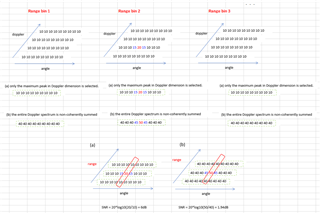Hello TI team,
I have a question about coherentDoppler which is 4th parameter of sigProcChainCfg in mmwaveL SDK 5.x.
This question is related to the thread below.
In the above thread, noise level increase is explained in terms of leakage factor in angle FFT.
But when I checked range-profile in visuzliser.exe, noise level increase is observed even where there is no peak.
Therefore I guess that the leakage factor is not relevant, is my understanding correct?
Please see the figure below.

I made a simple diagram below. In case of (a) which is only the maximum peak in doppler dimension is selected, SNR of range direction is 6, but in case (b) which is non-coherent sum, SNR is 1.9. Is this the basic principle of SNR degrades(noise increase) ?
If so, if we adjust CFAR threshold in each case, I think there is no difference between the two case in terms of detection performance (e.g., max detection range), is it correct? In the above thread, it is said that non-coherent sum is more robust, but I don't understand why it is robust. Could you let me know more detail of it?



